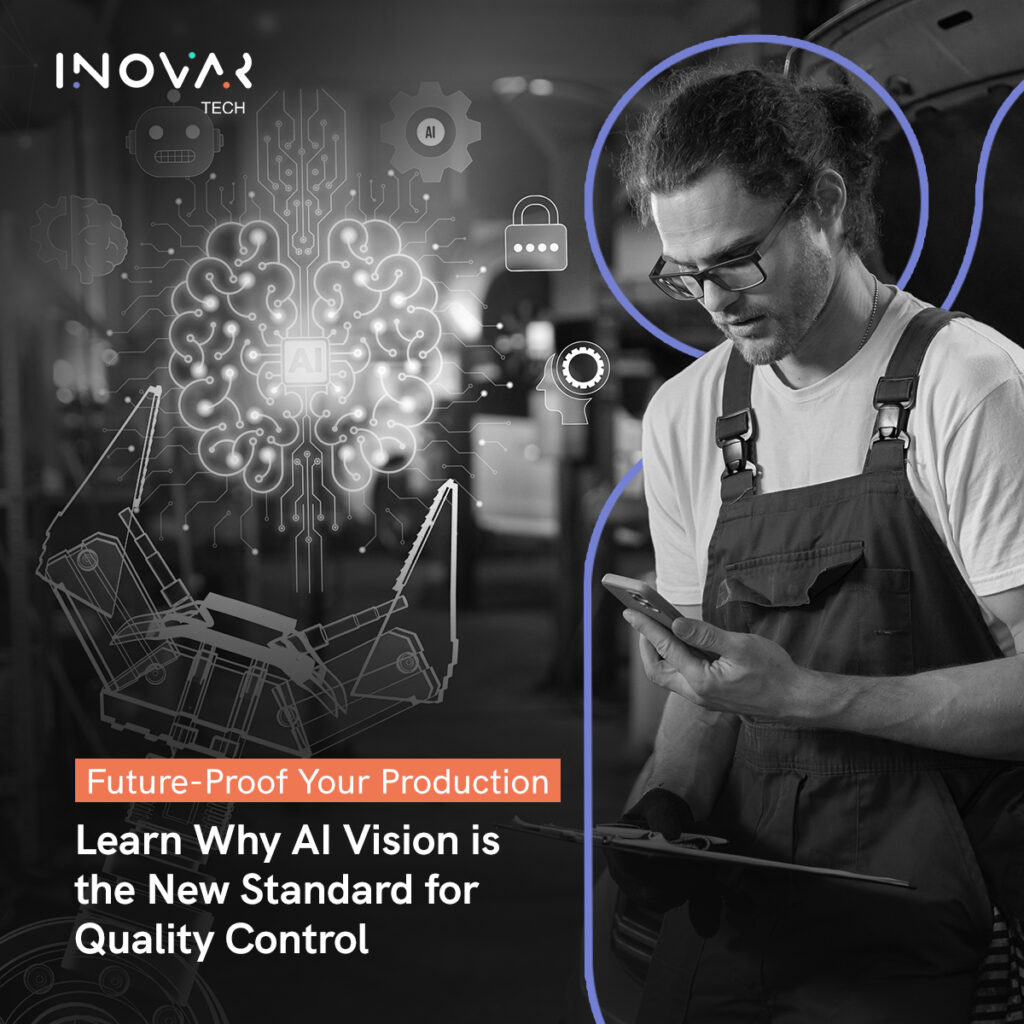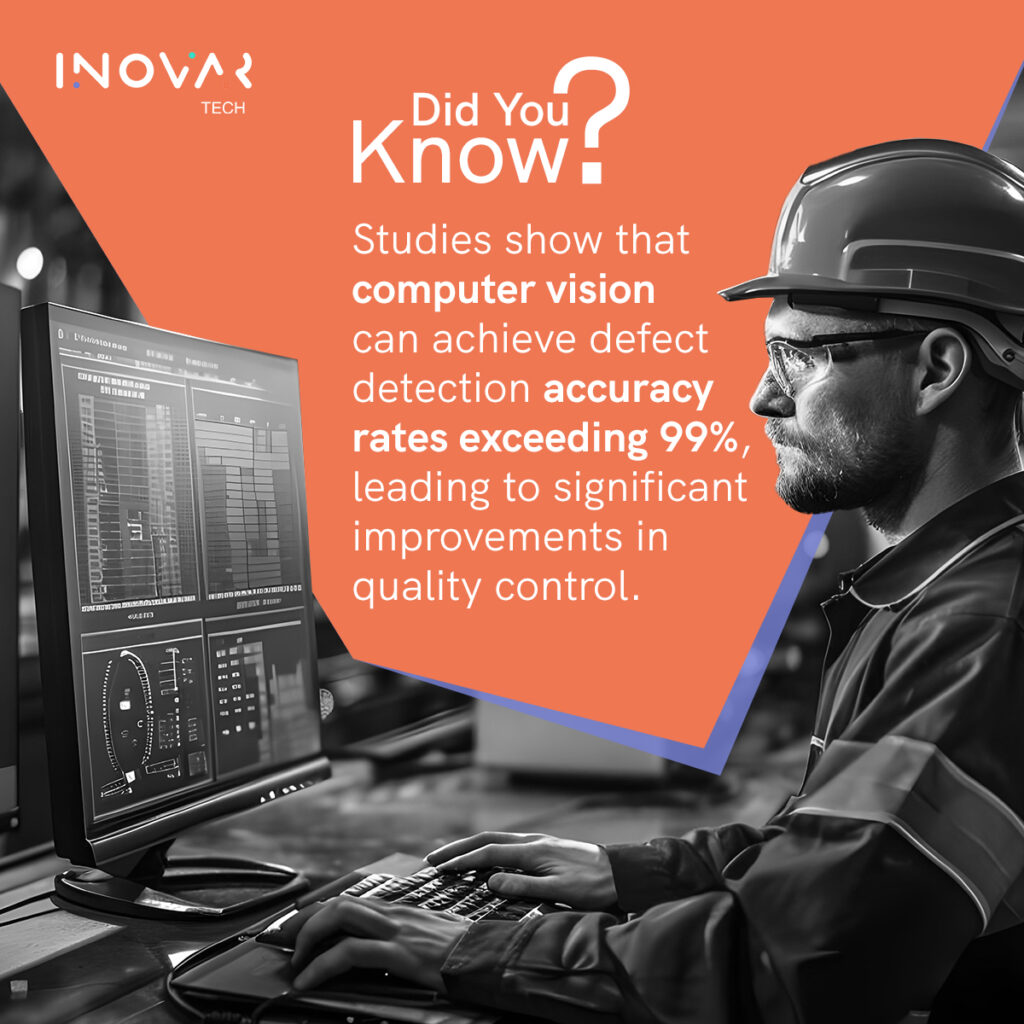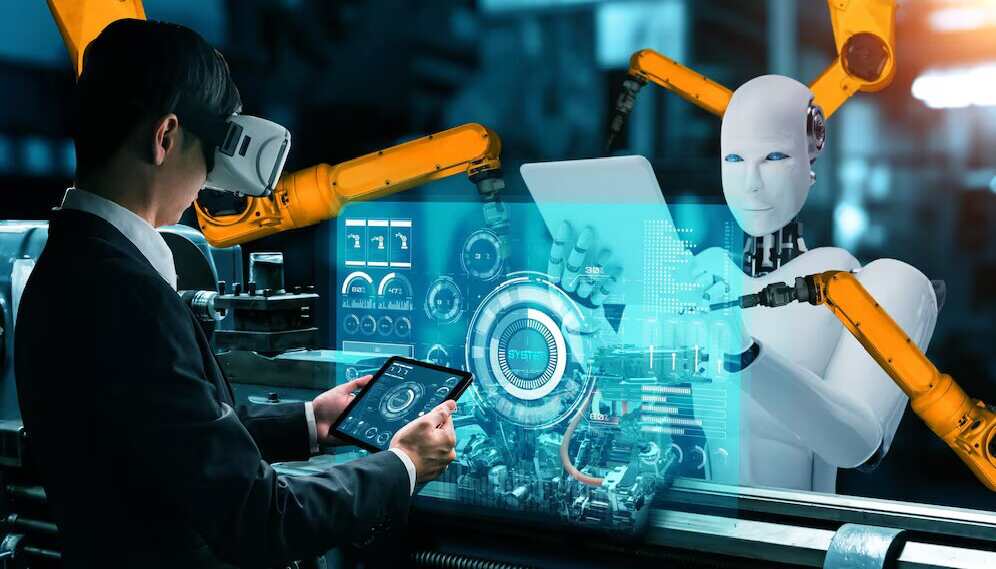Month: June 2024
Quality is a critical requirement in the manufacturing industry. High-quality products lead to several far-reaching benefits, including a stronger market position, competitive advantage, customer loyalty, and increased revenues. However, manually conducting quality control checks or relying on security cameras to monitor worker activity is time-consuming and cumbersome.
Increasing consumer focus on product quality and safety and evolving regulations demand a more fool-proof and innovative way to transform quality.
As quality becomes a differentiating factor across the manufacturing production line, there is an urgent and widespread need to move beyond traditional quality control techniques. Learn how computer vision fits the bill!

The Limitations Of Traditional Quality Control Approaches
Traditional approaches to manufacturing quality control often fall short of meeting the complex needs of modern-day quality requirements. With regulations constantly evolving, companies in the manufacturing sector are under immense pressure to ensure their products meet the necessary quality and safety standards.
Any deviation from the expected level of quality can lead to far-reaching consequences, impacting product quality, diluting business reputation, and resulting in hefty fines by regulatory bodies. Let’s look at the are some of the drawbacks of traditional approaches to quality control:
- Inconsistent results: Manually conducting quality checks can lead to inconsistent results. Since different teams might use different approaches and tools for quality control, it can lead to variability.
- Exhaustion: Quality teams that rely on manual approaches to quality control often experience fatigue and exhaustion in the long run.
- Error-prone: Using traditional tools and manual efforts is also known to result in errors and subjective quality assessments.
- Time-consuming: Manual approaches to quality control are also extremely time-consuming, affecting overall production speed and efficiency.
- Reactive: Manually viewing security camera footage for assessing worker behavior only provides evidence via stored tapes and cannot prevent quality issues from happening.
The Business Case for Computer Vision
Computer vision technology helps overcome the inherent challenges of manual quality control approaches. Underpinned by advanced automation, Artificial Intelligence (AI), and deep learning capabilities, computer vision significantly enhances the capabilities of traditional quality control systems. Through real-time monitoring and analysis of manufacturing processes, modern AI vision quality inspection copilots can help prevent quality incidents and pave the way for intelligent surveillance.
Today, these AI copilots are revolutionizing quality control, utilizing a multitude of algorithms for quality inspection results. Systems with computer vision technology can interpret and analyze video feeds in real time and offer unparalleled insights for proactive quality control measures.

Here are the top five reasons why businesses should invest in computer vision systems for intelligent surveillance:
1. Zero Human Error: AI vision quality inspection copilots guarantee 100% precision in quality inspection processes without human intervention. Easy to deploy, these AI models can provide accurate results with just a few images and data sets, improving your quality parameters in days rather than months.

2. Proactive Quality Inspection: In manufacturing quality control, computer vision systems use camera images and run algorithms to extract relevant insights. For instance, they can assess features like color, size, and shape of manufactured components and spot any deviations from the desired quality standards.

3. Behavior Analysis: Computer vision technology results in smarter, more efficient monitoring of production processes. By harnessing the power of real-time analytics, businesses can process and analyze vast amounts of visual data and enable rapid and accurate decision-making. For instance, computer vision algorithms can be trained to recognize and analyze human behavior patterns. This can help detect unsafe practices and trigger suitable responses.

4. Anomaly Detection: Computer vision technology greatly benefits in detecting anomalies in production processes. Utilizing deep learning architectures, it can inspect raw materials and finished goods for defects and ensure the highest level of quality. Unlike manual spotting, which is tiring and cumbersome, computer vision allows fast and accurate detection of unwanted or threatening objects. For instance, computer vision-enabled surveillance systems can scan raw materials to identify incorrect dimensions and prevent them from being used further in manufacturing.

5. Video Summarization: Manufacturers can also automate video summarization with computer vision technology. Instead of watching security camera footage in its entirety, they can quickly and comprehensively understand red flags. For instance, intelligent surveillance systems can generate a synopsis of captured footage, directing quality inspectors to the exact incidence of error.

6. Proactive Alerting: Computer vision systems can also trigger alarms whenever a spurious activity occurs. For example, the technology can inspect finished goods to identify damaged ones and alert staff to take them off the delivery line.

Revolutionize Quality Control with Computer Vision
Computer vision is a pivotal component of modern-day quality control, with applications extending far beyond traditional surveillance. Replacing traditional quality control with intelligent AI capabilities can perform a range of sophisticated analytics and contribute significantly to higher levels of security and quality.
From behavioral analysis to anomaly detection, video summarization, and proactive alerts, AI vision systems enable smarter, more responsive quality monitoring and control.
Looking to revolutionize quality control checks into a pillar of reliability and precision? Explore InovarTech’s AI copilot, VisionGuard, and learn how it allows flawless quality control via zero human error and total AI precision.
Customer service in the B2C domain has gone through a “rollercoaster” wave since the end of the global pandemic. 72% of customers plan to remain loyal to brands that provide fast and exceptional customer service. 78% of customer service agents find it challenging to balance between speed and quality of service. This has increased from just 63% in 2020. Rising service-related work pressure has increased labor turnover by 19% in customer servicing teams.
According to this McKinsey article, two-thirds of millennials expect to receive real-time customer service. Three-fourths expect a consistent cross-channel experience. It comes as no surprise that more companies are turning to AI technology to scale their customer service to the next level.
In this blog, let’s learn more about how AI can be leveraged to deliver highly personalized customer service even at scale.
What is AI-powered Customer Service?
AI-powered customer service is all about leveraging AI technology to scale every aspect of customer’s interactions with the brand. Depending on business requirements, customer support teams can utilize this technology in different ways.
For instance, AI-enabled chatbots can provide immediate responses to customer queries, instead of making them wait for a human response. According to HubSpot, 90% of customers rate it important to receive a prompt response (within 10 minutes) from service agents.
How does this benefit customer-focused companies? Besides increasing engagement, AI-enabled customer service tools can provide cross-selling and upselling opportunities. Besides, it works to reduce manual work, thus also the operational cost of customer support.
A Zendesk CX Trends report also found that customers are now comfortable with companies collecting their personal information. This enables companies to provide a personalized experience to their customers.
In 2024, 80% of customers have had a positive experience while interacting with an AI-powered customer service tool.
How does AI-powered customer service deliver a personalized experience at scale? Here are some ways:
- Leveraging customer data and insights
76% of customers want companies to leverage their data to provide a personalized experience,
With AI technology, customer support teams can have a more personalized interaction with customers. This requires them to completely understand the customer profile. On initiating this interaction, AI-powered tools provide customer service agents to understand their:
- Customer intent
- Preferred language
- Current sentiment
In turn, this is effective at improving the agent’s productivity and efficiency in addressing the customer query or problem.
- Self-servicing capabilities
In the wake of the COVID-19 pandemic, more customers started to migrate to self-service digital channels as their “first point of interaction.” 81% of customers try to take care of their issues before contacting a live agent.
AI-powered self-servicing tools leverage their ability to process natural language to understand customer queries and provide appropriate solutions. Using resources like knowledge bases and FAQs, AI in customer service can quickly find answers to customer queries – without having to wait for human intervention.
To assist customers, self-service portals can help them find their solutions, thus saving both time and effort.
- Predictive analytics
AI-enabled predictive analytics tools can drive more “precise and scalable” personalization. Using predictive analytics, companies can utilize customer data to anticipate their needs and behavior patterns. These insights allow them to:
- Address their customer queries proactively.
- Allocate optimum resources.
- Personalize the customer interaction.
By integrating predictive analytics into customer service, companies can continuously improve prediction models and stay “tuned” to customer preferences. To improve their prediction efficiencies, AI-powered models analyze various data sources including:
- Customer interactions
- Customer feedback and surveys
- Transactional data and buying history
- Social media
- Sentiment analysis
With its natural language processing or NLP capability, AI tools in customer service can easily understand and interpret human language. This can help this tool understand human sentiment and take appropriate actions. Besides this, AI-powered sentiment analysis tools can gauge the customer’s brand perception from:
- Customer feedback.
- Product (or service) reviews.
- Social media posts.
How does sentiment analysis improve customer service? Companies can use these AI-driven insights to personalize their customer experience and respond appropriately to their concerns. Besides, by using machine learning algorithms, sentiment analysis tools can detect “fake” reviews with 85% accuracy.
- Chatbots
According to the Zendesk CX Trends report, companies using AI in customer service could resolve issues 30% faster. AI-powered chatbots are crucial for providing faster responses and answers. Beyond simply answering customer queries, chatbots are delivering a personalized experience by:
- Greeting customers in a personalized tone.
- Guiding them through relevant business processes.
- Routing more complex queries to the right customer support agent.
Effectively, an AI-enabled chatbot acts as a “virtual buddy” that understands individual customer’s needs and preferences.
- Hyper-personalization
By combining AI technology with data and analytics, companies can now “hyper-personalize” their customer service. According to this Deloitte report, companies can hyper-personalize the entire customer journey including:
- Attracting customers with targeted marketing messages.
- Providing dynamic pricing to individual customers.
- Providing personalized services after the purchase.
Through hyper-personalization, companies can customize their products and customer services based on their data, preferences, and behaviors. Their real challenge lies in how to scale personalization without “overwhelming” the customer. Using AI technology, they can deliver personalized content that is in tune with changing customer behaviors and preferences.
Conclusion
Customer engagement is a focus point for companies of all sizes worldwide. As customers expect more personalized experiences, AI-powered customer service is the answer to keeping them engaged and loyal.
At InovarTech, we help you leverage AI technology for your business benefits. Our AI-enabled data analytics can scale your business to the next level. Get in touch with us to know more!
Remember the famous Apple tagline – ‘Think Different.’?
Well, it turns out that thinking differently and innovating is still crucial for a company’s survival and success. All disruptive companies – be it Apple, Google, Amazon, or Airbnb are examples of companies that dared to think differently and innovate.
In today’s rapidly evolving business landscape, fostering a culture of innovation is not just a necessity but a gateway to staying ahead of the curve. It’s an opportunity for companies to think beyond the conventional and meet the ever-changing market demands and customer expectations.
Companies now expect teams to bring a unique and fresh perspective to the table instead of limiting themselves to cookie-cutter solutions.
This change in expectations has raised an important question on the role of domain experts.
The Role of Domain Experts in Modern Organizations
A domain expert deeply understands an industry, technologies, frameworks, and best practices.
- They can understand the business needs and challenges and recommend solutions to solve them. For example, a banking domain expert will be well aware of all the processes in a bank and suggest process automation or optimization to improve customer experience.
- They can set up workflows or implement new technologies that help companies achieve their business goals.
- They leverage their deep business knowledge to choose the right solution for a business problem. For example, they can help companies choose the right cloud service provider that fits their budget and business needs and migrate the workload from on-premise to the cloud.
- They can provide the most cost-effective and best solution to the company.
They implement solutions and frameworks that they know can improve a company’s productivity and profitability.
They are a valuable asset to your team if you want solutions to a domain, process, or tool-related problem.
However, the real challenge arises when a problem requires innovative solutions. This applies especially to the current business environment, where technologies, trends, and demands evolve at a breakneck speed or when problems require a fresh perspective.
Domain experts often resist new ideas that challenge the status quo, become risk averse, and refuse to consider different perspectives that could solve a problem.
This reluctance to experiment or change perspectives creates a barrier to innovation and prevents companies from launching new products. As a result, companies lose the opportunity to generate more revenue and gain a competitive edge.
The only way to address this problem is to go beyond domain expertise and promote innovative thinking.
Here are a few ways to do that:
- Encourage cross-pollination of ideas
Since domain experts are exposed to a single domain, they cannot always bring new perspectives and experiences from different fields. Encourage cross-functional teams from diverse disciplines and experiences to collaborate and exchange ideas. For example, a fresh perspective from a non-domain expert can help you use existing technologies in unique ways. This will allow them to draw inspiration from each other and spark a cross-pollination of ideas that could lead to innovation.
- Bring unconventional and fresh perspectives to the table
Conventional wisdom and limited perspective due to prolonged exposure to a single domain often bog down domain experts. They limit their innovative thinking and hesitate to think differently. Such constraints do not limit non-domain experts. They are more flexible in considering, applying, and testing alternative approaches and methodologies to solve a problem. An unconventional approach also opens the door for building new solutions and business models that earn profits for the company.
- Balance between domain expertise and innovative mindset
No two processes or businesses are the same, even if they belong to the same industry. Thus, a one-size-fits-all solution would not help solve problems or build innovative products. This could result in an outcome that would look the same as that of the competitors, and you could lose out on creating a competitive advantage. Building a synergetic culture between domain and non-domain experts is essential. A domain expert will provide the necessary domain expertise and knowledge to implement a solution, and the innovative mindset of a non-domain expert can help companies think of creative solutions to a problem. This collaborative effort will help you build unconventional products and solutions that delight the customers and give your company an edge over competitors.
Use “The Art of The Possible” Approach to Think and Achieve the Impossible
If you want to build products that stand out from competitors and find a possibility in an idea that might seem impossible to launch, you need to shake up the status quo and don the innovator’s hat. You need to design a framework and a flexible approach that will help you visualize innovative solutions that can accelerate your growth in the digital transformation journey.
At Inovar, we help you do that with our ‘The Art of the Possible.’ approach.
Through this approach, you’ll learn:
- How to find inspiring ideas for your digital transformation journey regardless of your company size and industry.
- Ideate with different teams to find opportunities to capitalize.
- Innovate using a game-changing roadmap and stay relevant by adopting and leveraging the benefits of the ever-changing tools and technologies.
- Integrate our experience of working with different industries and technologies to find the perfect strategy for implementing your idea.
This will help you define the project scope, understand user gaps and customer pain points, conceptualize ideas to address the pain points, and visualize the future experience of your solution.
Contact us to know more about the approach.
Wrap-Up
Continuous innovation is the only way for companies to meet customer needs and stay ahead of competitors. Domain expertise, while essential, will not always help you think differently. It requires a change in mindset and less resistance to innovation.
Take Tesla, for instance. It wouldn’t have reached the height it did if it had solely relied on domain experts alone or did not dare to re-imagine the auto industry. The automaker studied innovative companies from within and outside the industry, understood the opportunities and gaps in the industry, developed its core competencies, and differentiated itself from other traditional players. They learned from different domains – from players in battery technology, solar energy, software engineering, and aerospace and incorporated their insights to become a leader in the space of electric vehicles.
So, don’t limit your ideas to follow a cookie-cutter approach. Use our Art of the Possible approach to encourage the non-domain experts in your company to contribute to the ideation process and build differentiated solutions and products.